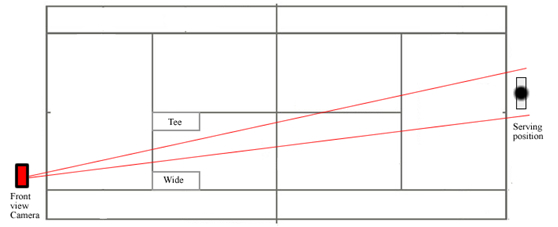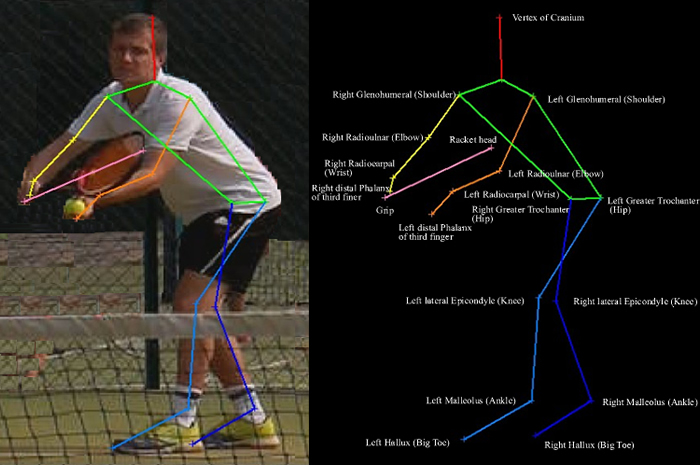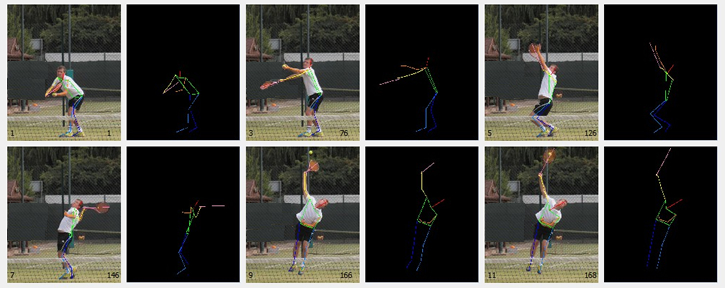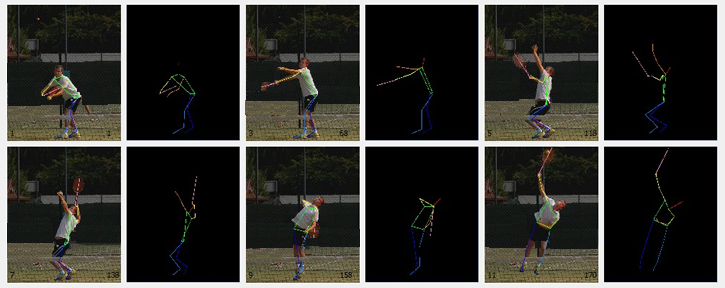|
Q4E Case Study 27 – Anticipating the placement of a tennis serve from stroke kinematics
Introduction In high intensity sports such as tennis, anticipation is fundamental to successful performance (Reid et al., 2010). Professional tennis players must anticipate and exploit key visual information from stroke kinematics in a quick and efficient manner, such to provide themselves sufficient time to plan and execute a successful return shot (Reid et al., 2011). This ability to anticipate future events quickly is particularly important when returning serve, since humans are inherently limited in terms of reaction time and movement time to plan and initiate effective responses (Glencross & Cibich, 1977). Due to this, numerous researchers have attempted to determine the mechanisms underpinning anticipation skill, and have in general found more skilled players to employ more effective visual search behaviours (Goulet et al., 1989; Singer et al., 1998) and to possess greater knowledge of situational probabilities (Shim et al., 2005; Ward & Williams, 2003). However, despite its clear importance as a source of visual cuing information, few studies have looked to quantify kinematic differences of the service motion when serving to different locations. Research by, Reid et al. (2011) has suggested that when serving out wide (on the deuce side), right handed players impact the ball further to their right, as well as standing with their front foot further from the centre mark. Comparatively, research using computer modelling systems has shown players to have faster forearm pronation when servicing down the left side of the service box, but faster elbow extension when serving down the right side. Consequently, this study aims to determine whether there are any differences in stroke kinematics when serving to different locations, and whether the returner can use these as a source of visual cuing information. Methods Subjects. Testing procedures. Figure 1. Target areas of the two serving locations
Data handling. Figure 2. 3-point digitisation markers Figure 3. 20-point digitisation markers Results Ball toss kinematics. Data are reported as grouped mean (±SD) data of the eight trials for both service locations. The vertical and horizontal displacement of the ball toss at racket contact was not significantly different for the T and Wide serves (Table 1), despite horizontal displacement (to the left) being greater when serving wide (Figure 4). Similarly, mean ball toss release height, peak ball height, toss time and lateral front position were all greater for the wide serve, although again none of these differences were significant (Table 1). Table 1. Racket and ball kinematics of the T and Wide serves Figure 4. Mean horizontal ball displacement for the T and Wide serves until racket contact Swing kinematics. Initial qualitative observations taken in real time showed no obvious kinematic differences when serving to the T and wide locations. When slowed down however, it did become apparent that a deeper right knee bend and consequently a longer loading phase occurred when serving out wide (Figures 5&6). When analysed quantitatively these observations were supported, with peak vertical knee displacement (0.06m), peak absolute knee angle (0.08 rads) and loading time (0.1s) all being greater when serving out wide (Table 2). Figure 5. Still image photo capture sequence of the T serve Figure 6. Still image photo capture sequence of the Wide serve Discussion Ball toss kinematics. The influence of serving to the ‘wide’ and ‘T’ locations was not found to significantly alter ball toss kinematics, despite some difference in lateral ball displacement at contact. This would suggest that for the returning player anticipation of the direction of the serve is almost impossible prior to ball contact. While the prominence of attending to service kinematics, in particular the ball toss is frequent in coaching of the service return, the extent to which it has been researched within the literature is perhaps surprisingly limited. Indeed, only Reid et al. (2011) who examined the set up, toss and racket kinematics of 6 professional male players using 3D motion analysis have previously looked to systematically quantify the affect of the service direction on the ball toss. Vertical displacement at impact, peak height, and toss time were indifferent whether serving out wide or down the T. However, lateral front foot position, as well as lateral displacement of the ball toss at its peak and at impact were found to be significantly different. Specifically, players stood closer to the centre mark when serving down the T and threw the ball up further to the left when serving out wide. While it has been shown that differences in lateral front foot position may not be a common cue, the shift in the toss left, from the T to wide serve is at least partially supported. This is particularly interesting since it provides evidence in contrast to what players and coaches might reasonably expect (Reid et al., 2010). That is, the positioning of a ball toss further to the right (for a right hander) is a time-honoured coaching cue for the development of the slice FS (Rineberg, 2004) – that which is typically associated with a wide serve to the deuce court. Therefore, as presented in coaching manuals (Yandell, 1999) and outlined by professionals it would appear that the skill of the player in maintaining lateral positioning of the ball toss when serving to different locations is key to preventing the returner any anticipatory information (Masters et al., 2007). Swing kinematics. Differences in stroke kinematics when serving to the wide and T locations were shown to be minimal. More specifically, when observed using qualitative analysis in real time, no clear kinematic differences could be shown, which suggests visual anticipatory information is limited. However, when observed in slow motion and quantitatively frame by frame, analysis did indicate some change in right knee flexion, although due to the lack of available data it is hard to reliably draw any meaningful conclusions from this. Instead, the findings oppose a growing body of literature (Abernethy, 1990; Ward et al., 2002) which suggests that more skilled players are better able to perceive anticipatory cues from both proximal and distal segments of their opponents swing kinematics. Therefore, in association with the work of Reidet al., (2011) it would appear that variance in swing kinematics when serving to different locations are minimal, inconsistent and virtually impossible to confidently anticipate. Future research. While the participant analysed in the present study showed little variation in service kinematics when serving to different locations, future research may look to distinguish the proportion of players (of a variety of playing levels) and the effect of this expertise. Likewise, it may also be beneficial to compare differences in serve kinematics when serving to different locations using topspin and slice. Finally, future work may also look to account for potential order effects by randomising the serve sequence, while it may too be beneficial to simultaneously examine the capacity of returners to attend to specific kinematic cues.
The results of this investigation suggest that players are able to maintain serve kinematics when serving in different directions, therefore limiting the visual information available to returning players to anticipate the location of the serve. References Abernethy, B. (1990). Anticipation in squash: Differences in advance cue utilization between expert and novice players. Journal of Sports Sciences, 8, 17-34. Glencross, D.J., & Cibich, B.J. (1977). A decision analysis of game skills. Australian Journal of Sports Medicine, 9, 72-75. Goulet, C., Bard, C., & Fleury, M. (1989). Expertise differences in preparing to return a tennis serve: A visual information processing approach.Journal of Sport and Exercise Psychology, 11, 382–398. Ida, H., Fukuhara, K., Kusubori, S., & Ishii, M. (2011). A study of kinematic cues and anticipatory performance in tennis using computational manipulation and computer graphics. Behavior research methods, 43, 781-90. Masters, R. S. W., van der Kamp, J., & Jackson, R. C. (2007). Imperceptibly off-centre goalkeepers influence penalty-kick direction in soccer.Psychological Science, 18, 222–223. Reid, M., McMurtrie, D., & Crespo, M. (2010). The relationship between match statistics and top 100 ranking in professional men’s tennis.International Journal of Performance Analysis in Sport, 10, 131-138. Reid, M., Whitside, D., & Elliott, B. (2011). Serving to different locations: set-up, toss, and racket kinematics of the professional tennis serve.Sports Biomechanics, 10, 407-414. Rineberg, D. (2004). Recipes for a tennis player’s soul. Hollywood, FL: Frederick Fell. Shim, J., Carlton, L.G., Chow, J.W., & Chae, W. (2005). The use of anticipatory visual cues by highly skilled tennis players. Journal of Motor Behaviour, 37, 164-175. Singer, R. N., Williams, A. M., Janelle, C., Frehlich, S. G., Barber, D., & L. Boutchard (1998). Visual search during ‘live’ on-court situations in tennis. Research Quarterly for Exercise and Sport, 69,109–116. Ward, P., & Williams, A. M. (2003). Perceptual and cognitive skill development in soccer: The multidimensional nature of expert performance.Journal of Sport and Exercise Psychology, 25, 93–111. Ward, P., Williams, A.M., & Bennett, S.J. (2002). Visul search and biological motion perception in tennis. Research Quarterly for Exercise and Sport, 73, 107-112. Yandell, J. (1999). Visual tennis. Champaign, IL: Human Kinetics. |
Tennis Serve | Quintic Sports







